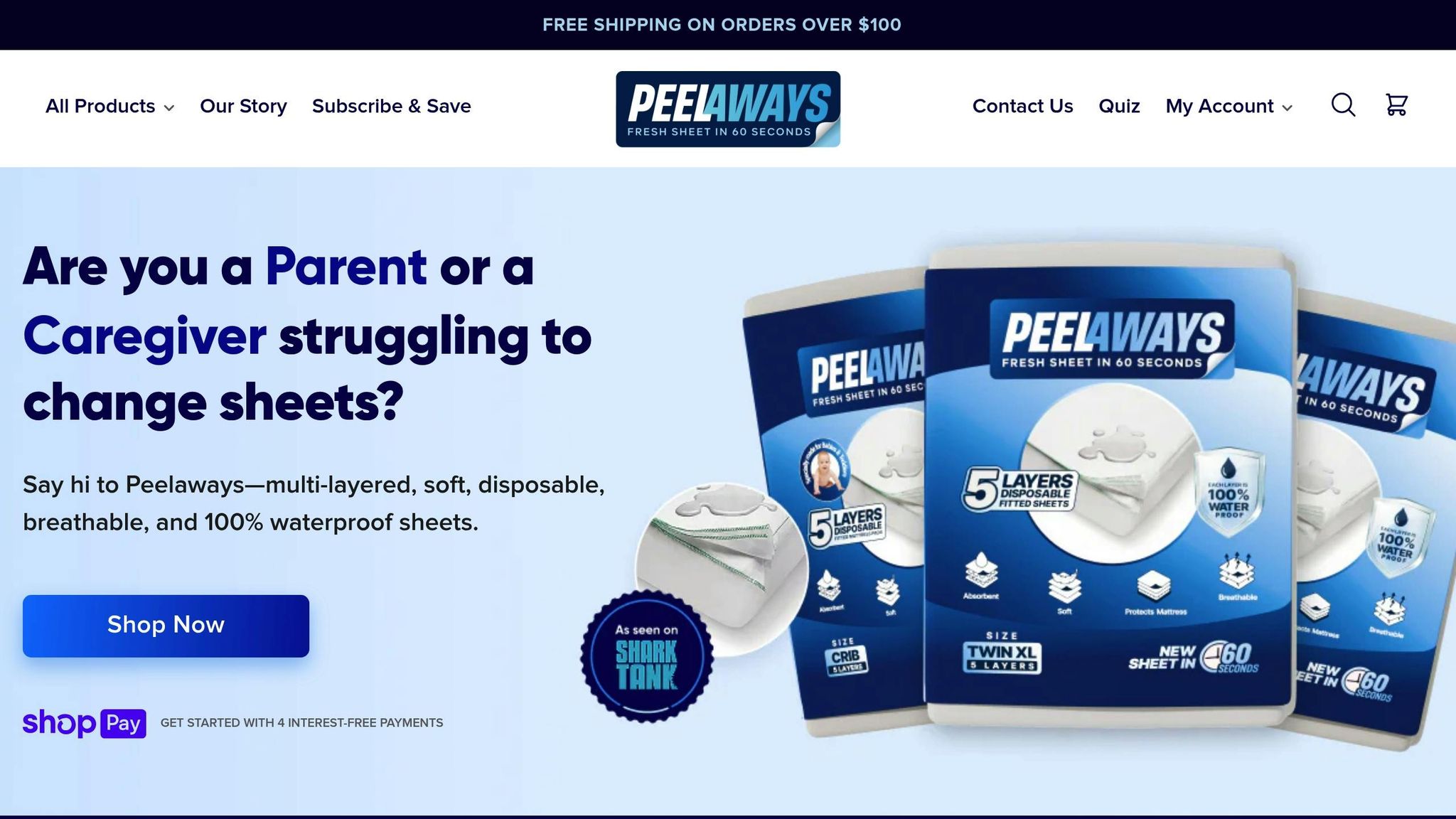Ultimate Guide to Family Incontinence Training

Managing incontinence for an elderly loved one can be challenging, but with the right approach, it becomes manageable. This guide focuses on practical caregiving techniques, emotional support, and tools like PeelAways disposable bed sheets to simplify the process. Here's what you'll learn:
- Training Benefits: Behavioral approaches like toileting schedules and prompted voiding can reduce accidents by 50% or more.
- Incontinence Types: Stress, urge, overflow, and functional incontinence each require tailored care strategies.
- Practical Tips: Use toileting diaries, adjust diets (e.g., reduce caffeine), and maintain hygiene to prevent skin issues and infections.
- Emotional Care: Approach conversations with empathy, involve your loved one in decisions, and support their dignity.
- Caregiver Well-being: Manage stress with breaks, support groups, and tools like PeelAways to reduce daily burdens.
PeelAways bedding offers a quick, hygienic solution for nighttime accidents, featuring multi-layered disposable sheets that simplify cleanup and improve comfort. This guide equips you with actionable steps to improve the quality of life for your family while reducing stress.
Ch. 5: Toileting & Incontinence (Caregiver College Video Series)
Incontinence Basics for Elderly Care
Understanding incontinence in older adults is crucial for caregivers aiming to provide effective support. While aging naturally brings changes that make incontinence more likely, it’s not an inevitable part of growing older. Learning the basics helps caregivers manage it better and equips them with the tools for targeted care.
As we age, the bladder loses some of its elasticity and capacity, making it harder to hold urine for long periods [15]. On top of that, the muscles controlling the bladder and sphincter weaken, which can lead to difficulties in managing urination [15]. These physical changes, combined with other factors, contribute to different types of incontinence.
Types and Causes of Incontinence
Knowing the types of incontinence can guide caregivers in choosing the right care approach. The most common types in older adults include:
- Stress incontinence: Leakage occurs when physical pressure - like coughing, sneezing, laughing, or lifting heavy objects - overcomes weakened pelvic muscles [6].
- Urge incontinence: A sudden, intense need to urinate often results in leakage before reaching the bathroom [6].
- Overflow incontinence: This involves frequent dribbling or small releases of urine due to incomplete bladder emptying, often caused by blockages or nerve damage [6].
- Functional incontinence: Bladder control remains intact, but mobility challenges, cognitive issues, or environmental obstacles prevent timely access to a toilet [6].
Some individuals experience mixed incontinence, combining symptoms of both stress and urge incontinence.
Identifying the root causes is essential for effective care. For example, hormonal changes during menopause can weaken pelvic muscles and reduce collagen, increasing the risk for women [15]. In men, an enlarged prostate can partially block the urethra, leading to incomplete bladder emptying and overflow incontinence [15]. Other contributing factors include urinary tract infections, chronic constipation, neurological conditions like stroke or Parkinson’s disease, and side effects from medications such as diuretics or sedatives [6]. Additionally, being overweight can add pressure to the bladder, and losing weight may help reduce symptoms [12].
Understanding these causes enables caregivers to tailor daily care and know when to seek medical advice. It’s also helpful to distinguish between transient incontinence - temporary and often reversible, caused by factors like infections or medication changes - and chronic incontinence, which persists due to ongoing conditions like muscle weakness or neurological disorders [6].
When to See a Doctor
Incontinence isn’t something to ignore, especially if it appears suddenly, worsens noticeably, or is accompanied by symptoms like pain, blood in the urine, fever, cognitive changes, recurrent urinary tract infections, difficulty starting urination, or falls [6]. These signs warrant a doctor’s evaluation.
During a medical evaluation, healthcare providers typically review the patient’s medical history, conduct a physical exam, and perform a urinalysis to check for infections or other issues [2][6]. They may suggest keeping a bladder diary to monitor urination patterns and, in some cases, order additional tests like pelvic ultrasounds or urodynamic studies to assess bladder function [2][6]. These steps help determine whether conservative treatments - such as lifestyle changes, pelvic floor exercises, or bladder training - or more advanced options like medications or surgery are necessary [2][5].
It’s important to manage expectations. For instance, bladder training can take anywhere from 3 to 12 weeks to show results [12], and even with treatment, occasional accidents may still happen. However, a well-rounded management plan can make these challenges easier to handle for both caregivers and families.
Practical Skills for Family Caregivers
Caring for a loved one with incontinence involves more than just addressing physical needs - it’s about preserving their dignity, easing stress, and creating a manageable routine. Success often comes down to a combination of observation, lifestyle changes, and good hygiene.
How to Track Patterns with a Toileting Diary
A toileting diary can be an incredibly useful tool for identifying incontinence patterns and triggers. By recording details such as time of day, fluid intake, food consumption, and episodes of incontinence, you can uncover trends that help guide care strategies [2][3].
Start by documenting every bathroom visit, successful or not. Include the exact time, what was consumed, and any relevant circumstances. For instance, note if an accident happened due to coughing, laughing, or simply not reaching the bathroom in time. Over time, this detailed tracking can reveal patterns you might not have noticed otherwise.
Consistently tracking these episodes also helps you adjust your approach and provides valuable information for discussions with healthcare providers. If you notice accidents tend to happen at specific times, consider scheduled toileting. Begin by taking your loved one to the bathroom hourly, then gradually extend the intervals as you identify their natural rhythm. Ideally, you’ll work toward a schedule where urination occurs every 3 to 4 hours [10][13].
Diet and Lifestyle Changes That Help
Once you’ve identified patterns, making adjustments to diet and daily habits can significantly reduce incontinence episodes. Diet plays a major role. For example, caffeine and alcohol act as diuretics, increasing urine production and often worsening symptoms [2][3]. Cutting back on these can lead to noticeable improvements in just a few days.
It’s also important to avoid common bladder irritants like spicy foods, acidic items, and artificial sweeteners. Problematic foods often include citrus fruits, tomatoes, chocolate, and certain sweeteners. Since everyone reacts differently, use your toileting diary to pinpoint specific triggers.
Hydration is a balancing act. While sufficient fluid intake - around two liters a day - is crucial to preventing constipation (a common contributor to incontinence), it’s wise to limit fluids closer to bedtime to reduce nighttime accidents [12][14]. Spread fluid consumption evenly throughout the day for the best results.
Regular physical activity, like walking or swimming, supports bladder health without overstraining pelvic muscles. If your loved one smokes, quitting can also help by reducing chronic coughing, which puts stress on the pelvic area [2][4].
For those who are overweight, even modest weight loss can ease pressure on the bladder and pelvic floor muscles, often resulting in fewer episodes [12].
Hygiene and Safety Steps
Maintaining proper hygiene is essential to preventing skin irritation and infections. Clean the genital area regularly using unscented wipes, and avoid harsh soaps or fragranced products that could cause irritation [4][7].
Continence pads and absorbent garments provide extra protection but shouldn’t replace medical advice or treatment. These products should be changed frequently to prevent skin irritation and odor, and selecting the right size and style is key for comfort and effectiveness [3][9]. Ensuring a proper fit helps avoid skin rashes and other complications [14].
Clothing choices can also make a big difference. Opt for machine-washable garments with velcro fasteners or elastic waistbands to simplify dressing and undressing. This makes bathroom visits quicker and reduces the likelihood of accidents [14].
Nighttime care requires additional precautions. Place a bedside commode nearby, ensure the bathroom is easy to access, and assist your loved one as needed to safely reach the toilet [4][10]. Regular toileting schedules can also help minimize nighttime accidents [4][10].
For bedding, products like PeelAways disposable bed sheets offer practical solutions. These multi-layer sheets feature 5 to 7 absorbent layers, depending on the size. When soiled, simply peel away the top layer to reveal a clean sheet underneath - no heavy mattress lifting or endless laundry required.
"They do not seep though to next liner and so much easier to use than changing sheets everyday for elderly." - linda [1]
PeelAways’ waterproof, breathable design helps protect against skin issues, such as pressure ulcers, especially for those who spend long hours in bed. Available in sizes ranging from Crib-A-Peel for toddlers to Twin, Full, Queen, and King, they also include Twin XL and Cot sizes with 7 layers for extended use. With over 8,000 reviews averaging 4.8 out of 5, these sheets have become a trusted choice for families managing incontinence [1].
sbb-itb-45288fe
Emotional Support and Communication
Dealing with incontinence goes beyond practical care - it also means addressing emotional challenges for both elderly individuals and their caregivers. Open communication and emotional support play a key role in easing the burden and maintaining dignity.
How to Talk About Incontinence
Discussing incontinence can be a sensitive topic, so it’s important to approach it with care. Start by selecting a private, relaxed setting where your loved one feels safe and at ease. The way you introduce the topic can shape how future conversations unfold.
Center the discussion on their comfort rather than the issue itself. Phrases like, "Let’s make sure you’re comfortable," can help shift the focus away from blame and toward support.
Active listening is crucial. Ask open-ended questions such as, "How are you feeling?" and take the time to genuinely hear their responses without jumping to solutions. Repeat back what they share to show you understand and validate their feelings.
Avoid using medical jargon - stick to simple, clear language. It can also be reassuring to explain that incontinence is common and manageable, not a personal failing. Sharing information about treatments and support options can help reduce any stigma they may feel.
Your loved one might experience emotions like embarrassment, shame, or anxiety about social isolation. Address these feelings with reassurance. Let them know they’re not alone and that many others face similar challenges. Normalize the experience and emphasize that seeking help or using supportive products is nothing to be ashamed of.
Whenever possible, involve them in decisions about their care. For instance, ask for their input on protective garments or their preferences for bathroom schedules. Some families have found success by working together to create a toileting schedule, while others use written reminders or encouragement to support participation in pelvic floor exercises. These strategies can help your loved one feel more in control and actively engaged in their care.
And don’t forget - taking care of yourself is just as important as caring for your loved one.
Managing Caregiver Stress
Providing care for someone with incontinence can be exhausting, both physically and emotionally. Be mindful of signs like constant fatigue, irritability, trouble sleeping, or withdrawal from social activities. If you notice these symptoms, consider reaching out to a professional for support.
Make self-care a priority. Even short breaks can help recharge your energy. Share caregiving duties with family members or friends, and don’t hesitate to ask for assistance. It’s normal to feel guilty about stepping away, but taking time for yourself can actually improve the care you provide.
Incorporate stress-relief techniques into your routine, like mindfulness exercises, deep breathing, or a quick walk outdoors. Set realistic expectations for both yourself and your loved one - some days will inevitably be tougher than others.
Simple solutions like PeelAways disposable sheets can reduce the strain of daily tasks, freeing up time to focus on emotional connection.
Consider joining support groups, either locally or online. Talking with others who share similar experiences can provide emotional comfort and practical tips. Organizations like the National Association for Continence offer a wealth of resources for families navigating incontinence care.
If possible, explore respite care services. These temporary care options allow you to rest and recharge while ensuring your loved one is still well cared for. Sharing responsibilities and seeking professional help when needed can help prevent burnout and maintain compassionate caregiving.
Finally, don’t underestimate the power of humor. If it feels natural and your loved one is comfortable, lighthearted moments can ease tension and make tough situations more bearable. Accidents will happen despite your best efforts, so try to stay calm and nonjudgmental. Keeping supplies handy for quick, discreet cleanups can also help you manage setbacks smoothly.
PeelAways Bedding Solutions for Incontinence Management

When it comes to managing incontinence, having the right bedding can make all the difference. PeelAways disposable bed sheets offer a practical and stress-reducing solution for families caring for elderly loved ones. These sheets simplify bedding changes and improve hygiene, making incontinence care far more manageable.
Why PeelAways Are a Game-Changer
PeelAways are designed with a patented multi-layer system that makes bedding changes quick and easy. Each sheet includes 5–7 absorbent layers (depending on the size), so when an accident occurs, you simply peel off the soiled layer to reveal a fresh, clean one beneath. This eliminates the need for lifting mattresses, reduces laundry loads, and minimizes the risk of cross-contamination. For caregivers, this design can be a lifesaver, offering a practical way to handle incontinence care more efficiently.
Each layer is equipped with a waterproof barrier to prevent liquids from seeping through to the mattress or the layers below. This not only maintains hygiene but also helps with odor control. The process of removing a soiled layer takes less than a minute - no heavy lifting required - making it especially helpful for caregivers who may have limited mobility or physical strength. The fitted design ensures the sheets stay securely in place, while their noiseless and breathable material ensures a comfortable, undisturbed sleep.
Hygiene is a major benefit of PeelAways. Since each layer is completely clean and untouched until it’s used, the risk of bacteria transfer is greatly reduced. This is particularly important in preventing urinary tract infections and skin irritation - two common issues in elderly incontinence care. By simplifying bedding changes, PeelAways also help reduce caregiver stress. With over 6,000 five-star reviews and an impressive 4.8 average rating [1], it’s clear that these sheets have made a positive impact on thousands of families.
Sizes and Options to Fit Every Need
PeelAways come in a variety of sizes to suit different beds and care requirements:
| Size | Dimensions | Depth | Layers | Price |
|---|---|---|---|---|
| Crib-A-Peel | 52" x 28" | 6" | 5 | $30.99 |
| Cot | 75" x 30" | 6" | 7 | $34.99 |
| Twin | 75" x 39" | 6" | 5 | $34.99 |
| Twin XL | 80" x 39" | 9" | 7 | $41.99 |
| Full | 75" x 54" | 12" | 5 | $43.99 |
| Queen | 80" x 60" | 12" | 5 | $47.99 |
| King | 80" x 78" | 12" | 5 | $53.99 |
The Twin XL size is especially popular for elderly care, as it provides 7 layers and fits adjustable beds often used in caregiving settings. For split king bed setups, two Twin XL sheets can be combined to cover the entire surface.
Other sizes cater to specific needs: the Crib-A-Peel is ideal for potty training or special needs care, while the Cot size works well for hospital beds and care facilities requiring frequent bedding changes. When choosing a size, consider how often accidents occur and how many layers you’ll need before replacing the sheet. The 7-layer options are particularly cost-effective for situations with high care demands.
PeelAways also make thoughtful gifts. The company offers gift cards starting at $25, along with free shipping on orders over $100. Subscription orders come with a 15% discount, making it easier to keep supplies on hand for ongoing care.
Safety is another priority for PeelAways. All products are free of harsh chemicals like vinyl, PVC, phthalates, and fire retardants, ensuring they’re safe for extended skin contact. This is especially important for elderly individuals with sensitive skin or those who spend long periods in bed.
Key Points for Family Incontinence Training
Managing incontinence effectively requires a mix of practical skills, emotional understanding, and the right tools. Research shows that behavioral strategies often deliver better results than relying solely on medication [11]. Here’s a closer look at some essential strategies for family caregivers.
Family participation makes a big difference. When caregivers use methods like scheduled toileting and prompted voiding, the frequency of incontinence episodes can drop by 50% or more [11]. This hands-on involvement is key to achieving long-term improvements.
As mentioned earlier, tracking patterns with a toileting diary is a critical first step. By identifying trends, families can create tailored care plans. Pairing this with simple dietary changes - like cutting back on caffeine and alcohol or managing fluid intake - can help reduce symptoms significantly [3][12].
Compassionate communication is essential. Talking about incontinence can be uncomfortable, but approaching these conversations with empathy and focusing on solutions rather than the problem itself can help ease stigma. This open dialogue fosters cooperation and makes management efforts more effective for everyone involved [7][8].
On the practical side, innovations like PeelAways bedding have simplified care. These products minimize the hassle of constant laundry and heavy mattress lifting. As one caregiver explained:
"These have saved my sanity! With 2 incontinent special needs teenagers... these have relieved a lot of stress. They hold a LOT of liquid and are easy to use and tear away. No more 15 loads of laundry and wet mattresses!" - Jalene Stanger
By combining behavioral techniques with practical tools like PeelAways, families can see the best results. In fact, research shows that combining behavioral and drug therapies can reduce incontinence by 85%, compared to just 57% when using a single approach [11]. This highlights the importance of a well-rounded care plan.
Finally, don’t hesitate to lean on available resources. Community nurses, support groups, and organizations like Bladder & Bowel UK can provide valuable guidance and ongoing support [4][7]. The key to success is staying consistent while adjusting strategies to fit your family’s unique needs.
FAQs
How can I identify the type of incontinence my loved one has and provide the right care?
Identifying the type of incontinence your loved one is dealing with typically calls for an evaluation by a healthcare professional. They can assess symptoms, run tests, and provide a clear diagnosis.
After pinpointing the type, care plans may involve a mix of approaches - like lifestyle adjustments, targeted exercises, medications, or practical tools such as disposable, waterproof bed sheets. These sheets can ease the burden of managing incontinence by cutting down on laundry and maintaining a clean, hygienic sleeping space. Thoughtfully designed products like these can bring comfort and convenience to both caregivers and families alike.
How can I manage my loved one's diet and hydration to help reduce incontinence episodes?
Managing diet and hydration can make a noticeable difference in minimizing incontinence episodes. Here are some straightforward tips to help:
- Hydrate smartly: Drink fluids regularly throughout the day, but try to cut back in the evening to reduce the chances of nighttime accidents.
- Watch out for irritants: Limit or avoid common bladder triggers like caffeine, alcohol, and spicy foods, as they can worsen symptoms.
- Maintain a routine: Keeping consistent meal and drink schedules can help regulate bladder and bowel activity more effectively.
To make caregiving less stressful, consider using multi-layered, disposable, and waterproof bed sheets like Peelaways. They simplify cleanup, saving you time and effort while ensuring comfort for everyone involved.
How can I handle the emotional challenges of incontinence care for both my loved one and myself?
Caring for a loved one dealing with incontinence can be a tough emotional journey - for both the caregiver and the individual. It's natural to experience feelings like stress, frustration, or even embarrassment, and addressing these emotions openly is key. Compassionate and honest communication can go a long way in fostering an environment where everyone feels heard and supported.
Finding emotional support is just as important as managing the physical aspects of care. Therapy, counseling, or joining caregiver support groups can offer valuable coping strategies and a sense of community. On the practical side, tools like disposable multi-layer bed sheets can make a big difference. They simplify cleanup, reduce stress, and free up time to focus on what truly matters - providing care and emotional connection.
Related Blog Posts
- 7 Essential Tips for Nighttime Incontinence Care
- Best Certification Programs for Incontinence Care Training
- Checklist for Streamlining Incontinence Care Tasks
- Ultimate Guide to Emotional Care in Incontinence Management
Comments
0

SAVE MONEY & WATER
Professionals & Institutions save a fortune on labor/laundry.

SUPERIOR COMFORT
The first thing our customers notice is how soft our sheets are.

100% WATERPROOF
Each layer is 100% Waterproof, perfect for spills and accidents

SAVE TIME
Change the sheet in under 1 minute without stripping the bed.




Leave a comment